Warning: pic heavy, as usual. 
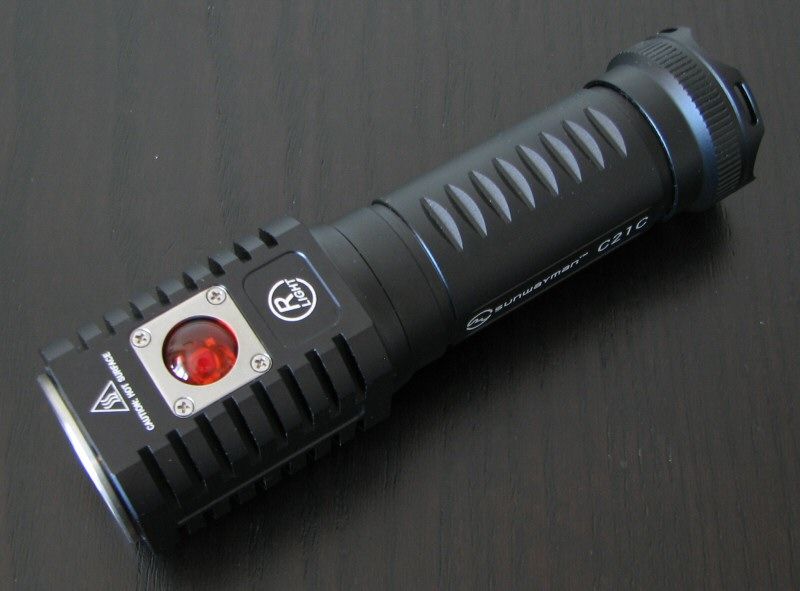
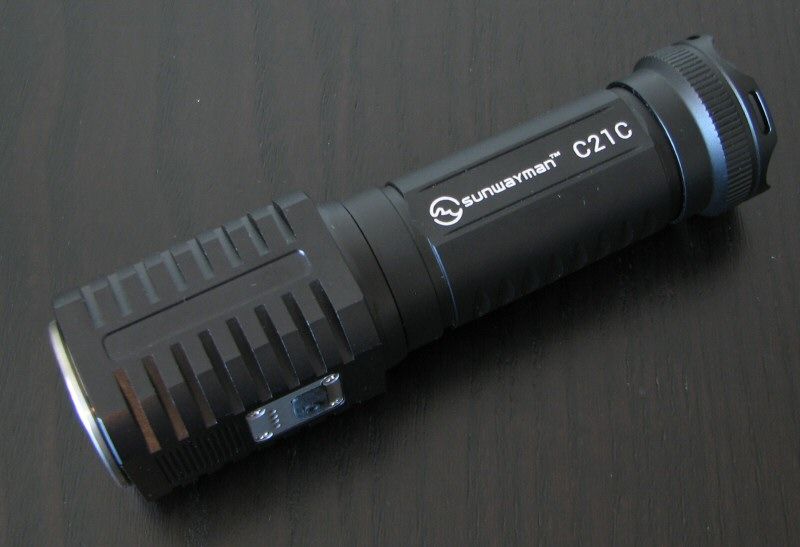
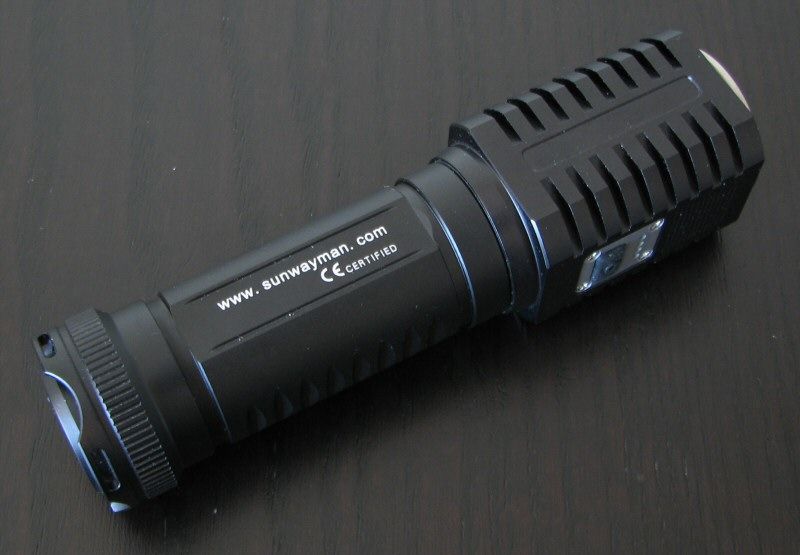
Sunwayman has updated their streamlined 1x18650 offering – the C20C – with a new dual-emitter version, the C21C. This new light is distinctive for having a XM-L2 cool white main emitter, and a XR-E red side emitter.
Sunwayman continues its recent tradition of naming all of its models – the C21C sports the moniker of "Thunder Hammer". Perfect for everyone's favorite Norse god.
Let's see how the model has evolved - and how it compares to other recent lights in the popular 1x18650, 2xCR123A/RCR class of XM-L2 lights.
Manufacturer Reported Specifications:
(note: as always, these are simply what the manufacturer provides – scroll down to see my actual testing results).
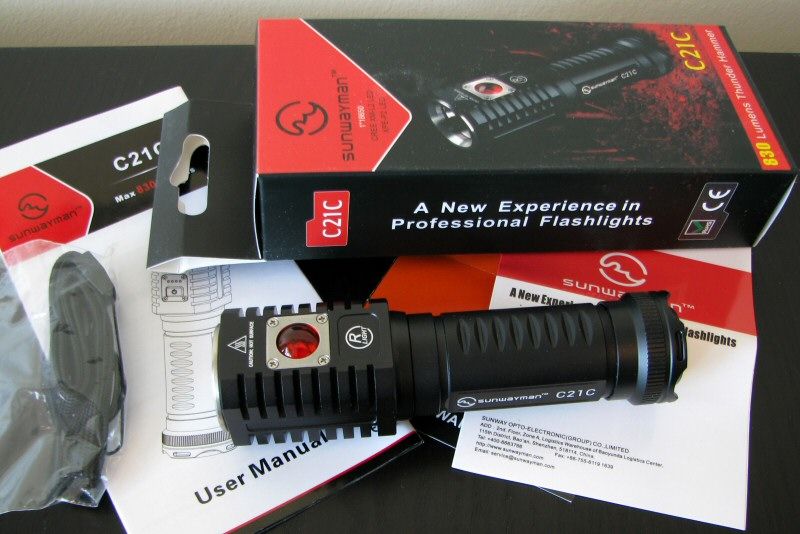
The C21C comes in the standard Sunwayman display-style cardboard box with product information printed right on the package. Inside you get a wrist lanyard, extra o-rings, manual and product inserts. There is no belt pouch or clip included.


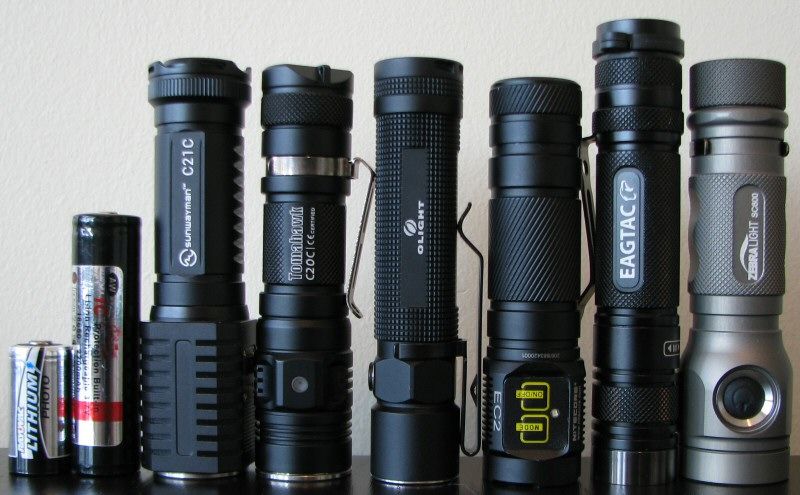
From left to right: Rayovac CR123A; AW Protected 18650 2200mAh; Sunwayman C212C, C20C; Olight S20-L2; Nitecore EC2; Eagletac D25LC2; Zebralight SC600.
All dimensions directly measured, and given with no batteries installed:
Sunwayman C21C: Weight 78.6g, Length: 102.0mm, Width (bezel side) 26.9mm (bezel diagonal) 31.2mm
Sunwayman C20C: Weight 57.6g, Length: 104.8mm. Width (bezel): 25.6mm, Width (head at widest part): 28.6mm
Eagletac D25LC2: Weight: 50.0g, Length: 116.3mm, Width (bezel): 22.5mm
Eagletac G25C2-II (stock): Weight 141.0g, Length: 150.6mm, Width: 39.6mm
Eagletac TX25C2: Weight 93.6g, Length: 120.4mm, Width (bezel): 31.6mm
Foursevens Quark Q123-2 X (Regular tailcap): Weight: 44.6g, Length: 112.7mm, Width (bezel) 22.0mm
Jetbeam PC20: Weight: 60.0g, Length: 127.5mm, Width (bezel): 22.6mm
Olight M21: Weight 119.5g, Length 145.2mm, Width 38.5mm (bezel)
Skilhunt S2: Weight: 133.0g, Length 153.0mm, Width: 36.0mm
Zebralight SC600 II: Weight 79.3g, Length: 108.0mm, Width (bezel) 29.7mm
Overall dimensions are similar to other compact/petite lights in this class.
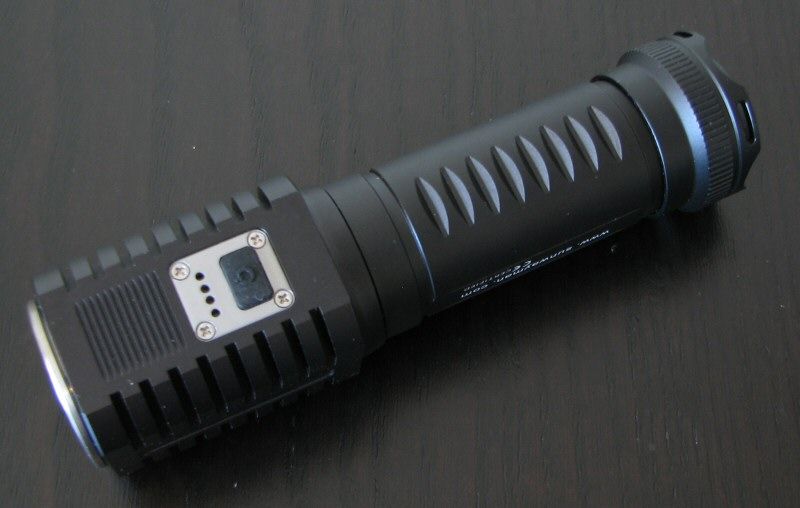
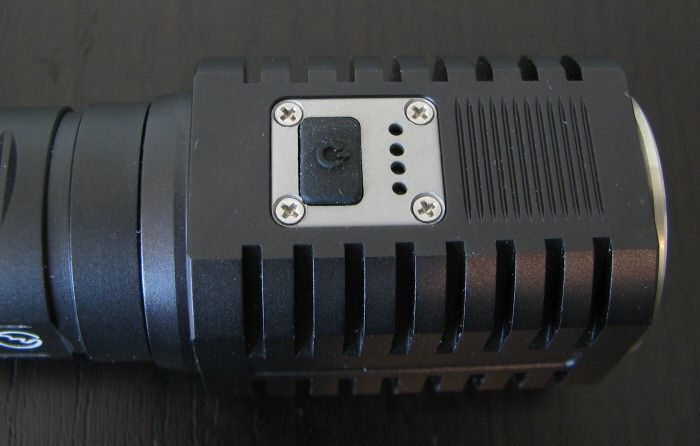
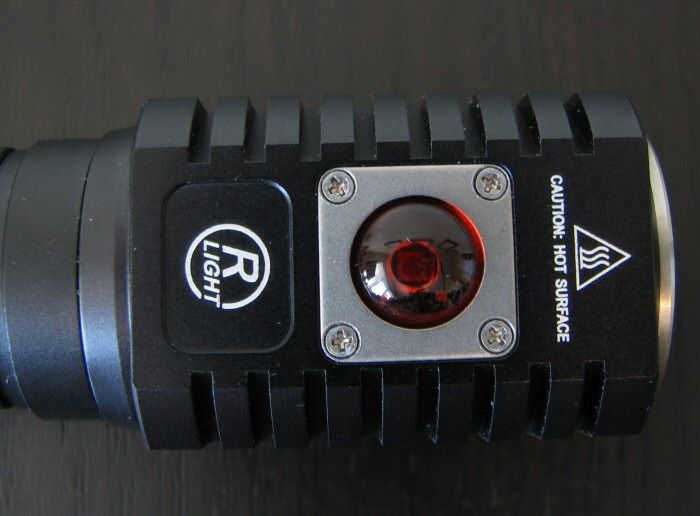
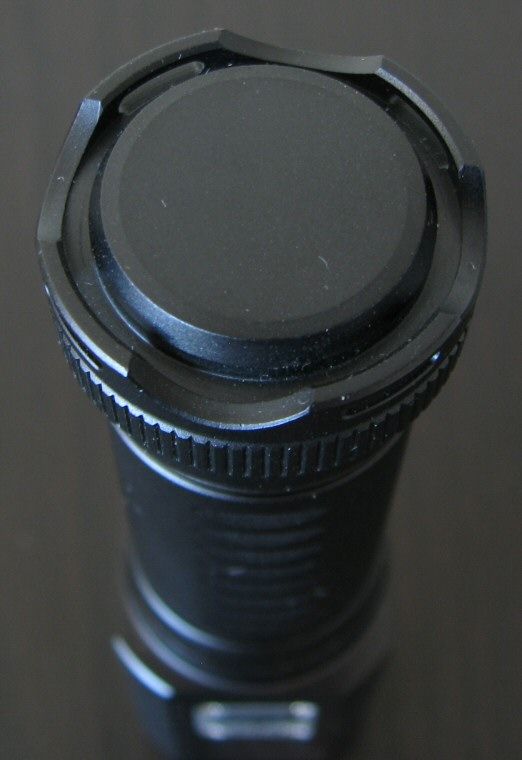
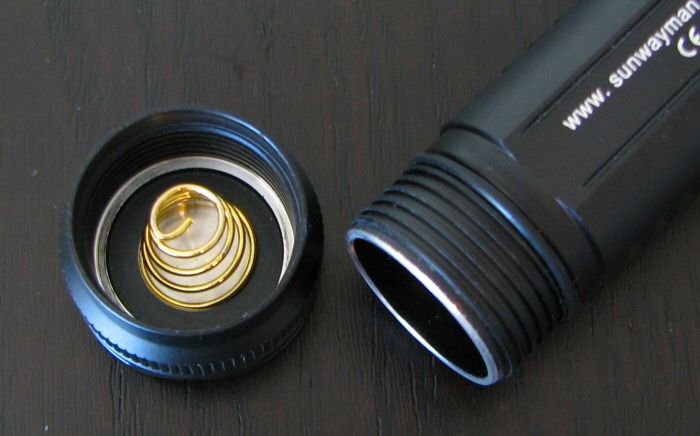
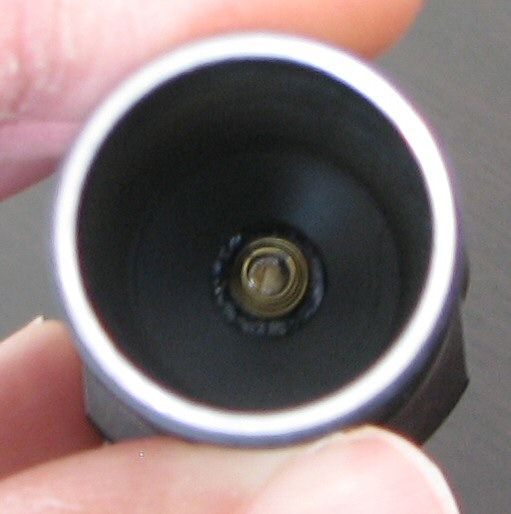
The appearance of the C21C is certainly a departure from the C20C. The most obvious change is the square-shaped head and side-mounted red LED (under a red dome).
The size of the main electronic switch is also a lot less pronounced now. Not quite sure why this latter change was made, but I suppose it could reduce accidental activations (which were an issue on the C20C). But it also makes it a bit harder to find the switch by touch alone now. :shrug: Switch feel is reasonable for this type of switch, with a definite "click" upon activation. There is also a dedicated low-battery warning LED indicator just above the switch. Scroll down for a discussion of the UI.
As with several other recent Sunwayman lights, the light comes in black anodizing, type III (hard anodized), in a matte finish. Personally, I miss the dark gray natural finish anodizing of old. As always, all labels are fairly small and bright white against the dark background.
There is no real knurling to speak of on the C21C, but there are a number of ridge elements on the body and fine gradations on the tailcap. Given the shape of the light, I would say overall grip is reasonable. I am not clear on why Sunwayman dropped the pocket clip on the C21C. It would be particularly useful here, given the side-mounted red LED (i.e., to clip it onto you for use like an angle-head light). :thinking:
The light opens at the tailcap, and screw threads are a thick square-cut and fully anodized for lock-out. :thumbsup:
The body tube is wide enough to take protected 18650 cells, as well as 2xCR123A/RCR. You might find longer cells a bit of tight fit, given the spring in the head. On the plus side, all flat-top cells will work in the light.
There is a stainless steel bezel for the main white emitter.
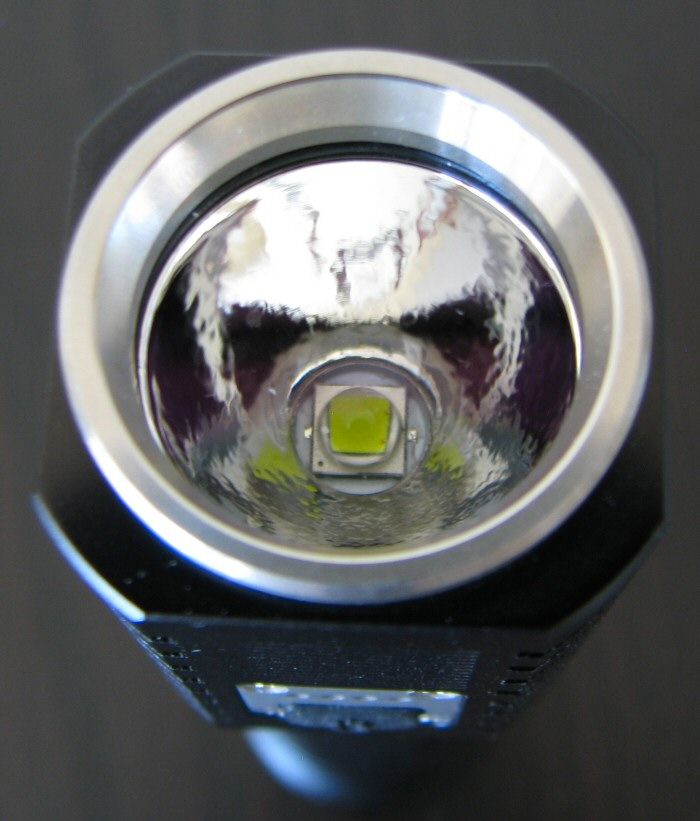
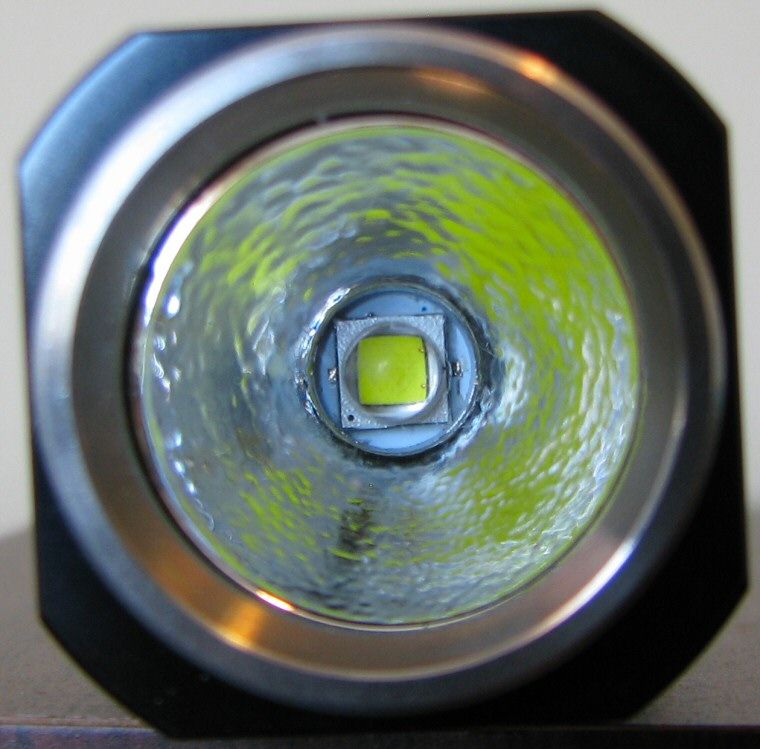
The main reflector is textured, to a medium orange peel finish. XM-L2 cool white emitter was well centered on my sample.
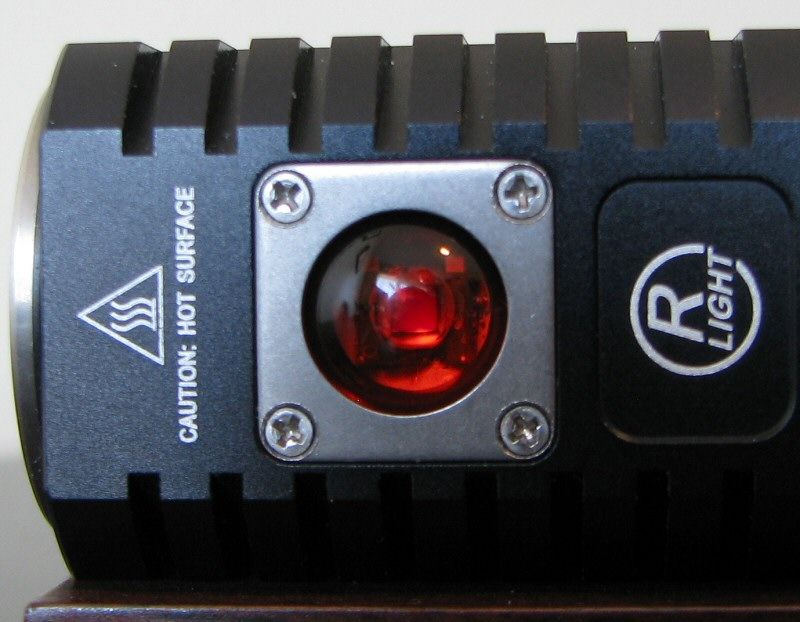
Sunwayman confirms that there is an actual red XP-E LED under there (hard to tell with the red dome). In the absence of a reflector, the convex optic helps to focus light into a defined beam (scroll down for beamshots). Not quite sure why they used a red-tinted optic, unless this was to narrow the wavelength even further. :shrug:
User Interface
Turn the white light on by clicking the electronic switch (i.e. a quick press and release, from off). Click again to turn the light off. Turn the red light on by pressing and holding the switch (from off). Again click to turn off.
There are four main output levels of white light, selected by pressing and holding the switch when on. The light will advance through all the levels in the following repeating sequence: Turbo > Hi > Med > Lo.
For the red light, you similarly press and the hold the switch again (after turning the red light on) to change levels. The level sequence is Hi > Med > Lo, in a repeating loop.
The light has level memory, but only for the current mode. So for example, if you turn the light off in the white Lo mode, and then re-active (in white), you will get Lo again. But if you re-activate in red, the white level memory is erased and the new red level is saved upon turning off the light. :shrug: Note also that the default level is max output, for either mode (i.e., when you switch to the other color, it first activates in max).
Double-click from on (in either white or red mode) to activate Strobe. Double-click again to advance to SOS. A single click returns you to constant on.
As this is an electronic switch, a standby current is required (see below for measurements). From on, do a quick click followed immediately by a press-hold. After 1 sec, the light will shut off and cannot be re-activated until the lockout is deactivated. To restore full functioning, double-click the switch followed by a press-hold. Note that manual is bit unclear on this point (i.e., it says to use the same procedure to lock and unlock, when in fact you need to do an extra click to unlock).
There is a low voltage warning indicator on the light, just above the electronic switch. It comes on (constant on) when the batteries are nearly depleted. I didn't test to see specifically when it activates, but I did notice it at the end of some of my runtimes.
Video:
For information on the light, including the build and user interface, please see my video overview:
Video was recorded in 720p, but YouTube typically defaults to 360p. Once the video is running, you can click on the configuration settings icon and select the higher 480p to 720p options. You can also run full-screen.
As with all my videos, I recommend you have annotations turned on. I commonly update the commentary with additional information or clarifications before publicly releasing the video.
PWM/Strobe
As with most of my Sunwayman lights, I don't see any signs of pulse width modulation (PWM) on the lower output modes. There is some measurable circuit noise on my C21C, in some modes – although it is not visible to the eye:
White Med Noise:


White Lo Noise:
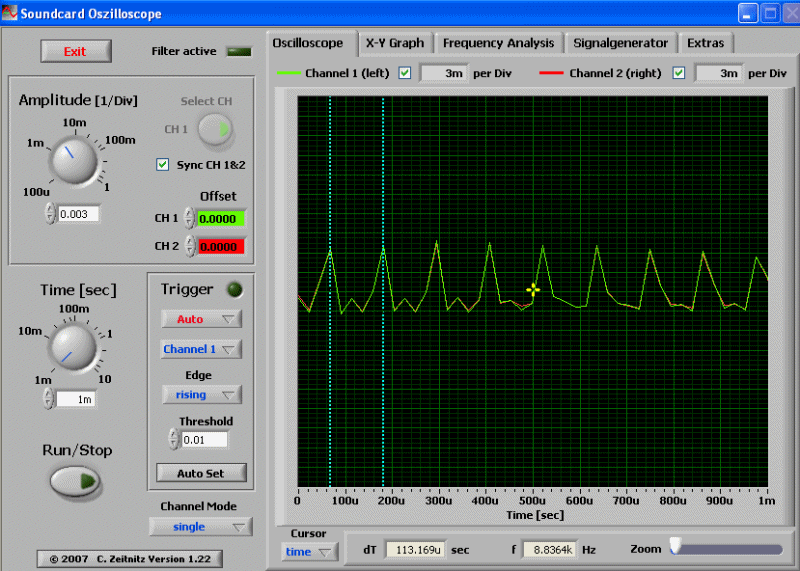
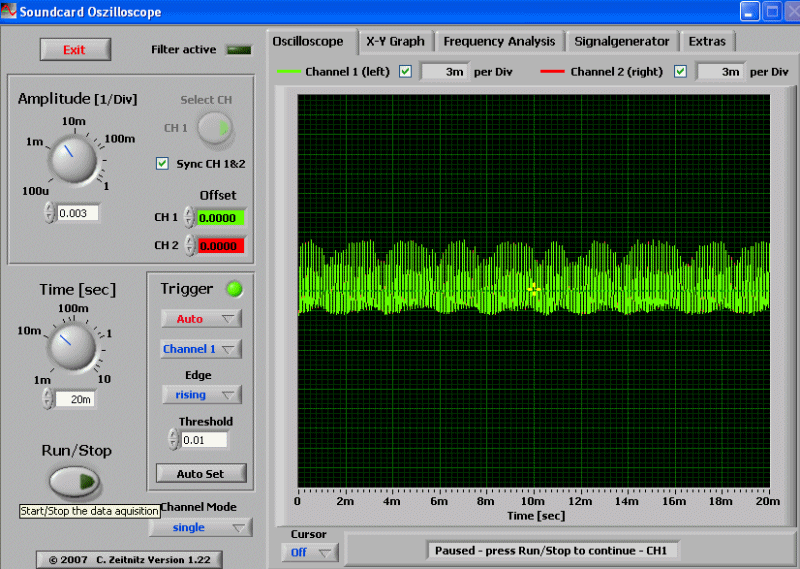
I don't see any circuit noise on the Hi or Turbo white modes, but the above patterns are detectable on Lo (9 kHz) and Med (22 kHz). Only the Med mode noise was intense enough to be able to see visually when shinning on a fan. However, I didn't detect any visual flicker in actual use (and I am personally sensitive to flicker effects).
White Strobe:
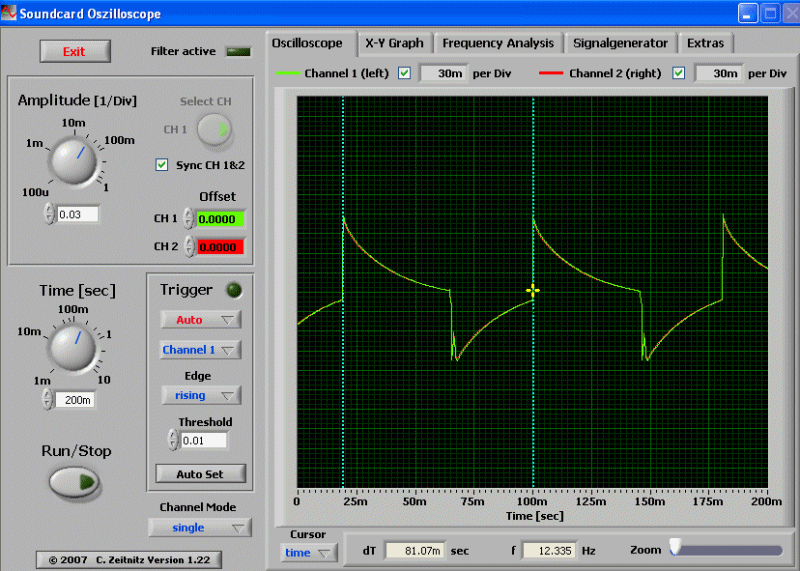
The main strobe is a typical high frequency ~12 Hz strobe. Note that I can detect a bit of circuit noise at the end of each strobe pulse.
White SOS:
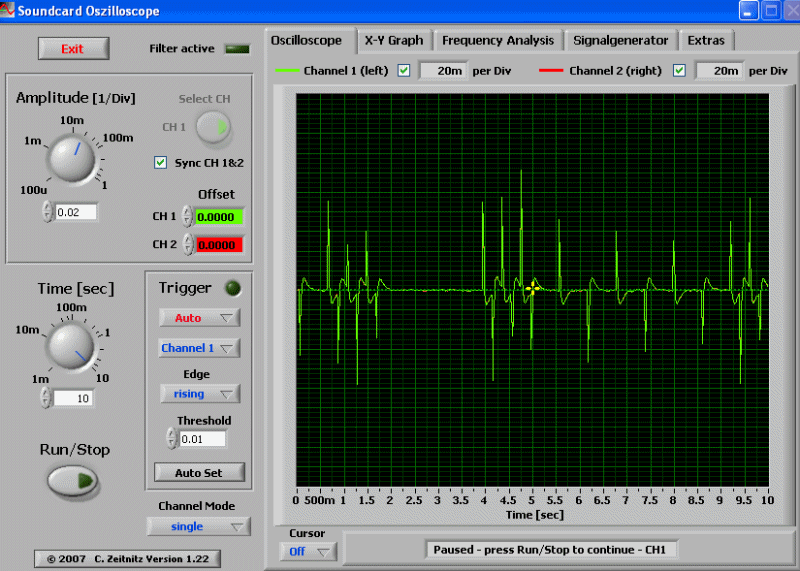
The C21C has a typical SOS mode.
Red mode Hi Noise:
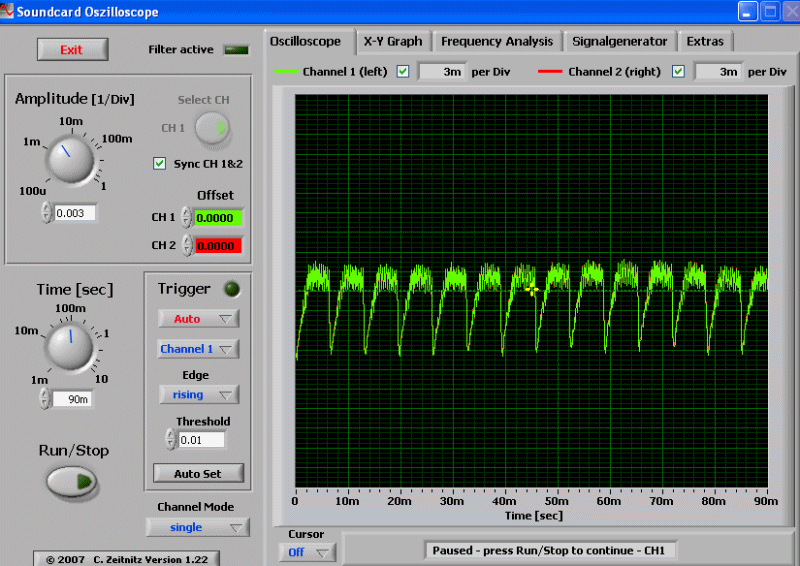
On the Red light, I detected circuit noise on the Med and Hi modes with my oscilloscope, whereas Lo was perfectly stable. Again, I could see no sign of flicker on any of the red modes in actual use (but you may be able to see the noise when shining the light on a fan).
Red mode Strobe:
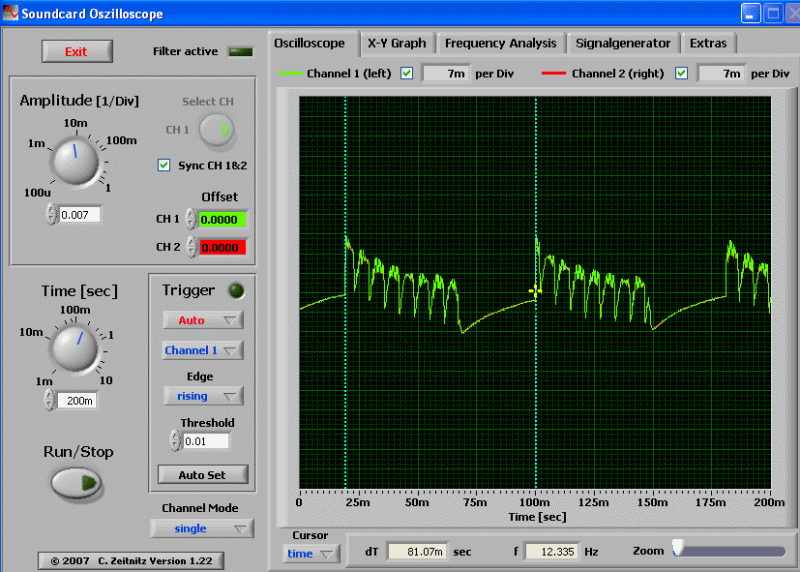
The red strobe is the same fast 12 Hz strobe, although you can again see the Hi mode circuit noise in the trace above.
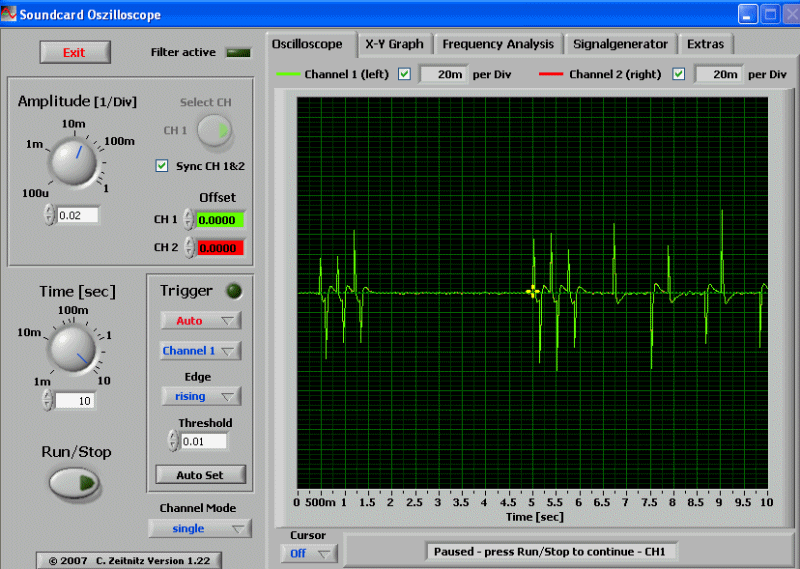
Red SOS mode is also fairly typical.
Take home message: don't worry about these oscilloscope-detectable noise patterns. They are of sufficiently high frequency (multi-kilohertz range) and low intensity as not to be detectable visually. :wave:
Standby Drain
As the switch is an electronic one, a standby current drain is always present when a battery is installed.
When I first connect my DMM, I measured an initial current of ~880uA (on an 18650 cell). However, after a few seconds, the stand-by drain dropped to 13.3uA, and remained there stably. This would translate into nearly 27 years before a 3100mAh battery would be drained. It is definitely negligible, and not a concern.
Sunwayman provides an electronic lock-out mode that is activated by a quick click followed by a sustained press (see UI section – same as the C20C). You can also physically lock-out the C21C by a twist of the tailcap (thanks to the anodized threads).
Beamshots:
For white-wall beamshots below, all lights are on Max output on an AW protected 18650 battery. Lights are about ~0.75 meter from a white wall (with the camera ~1.25 meters back from the wall). Automatic white balance on the camera, to minimize tint differences.
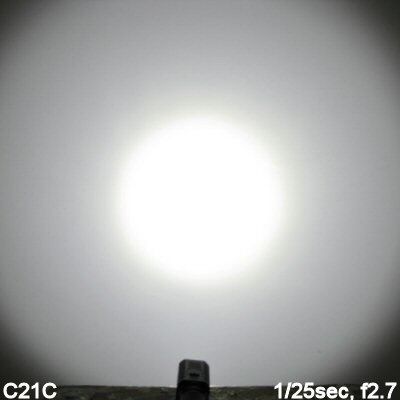
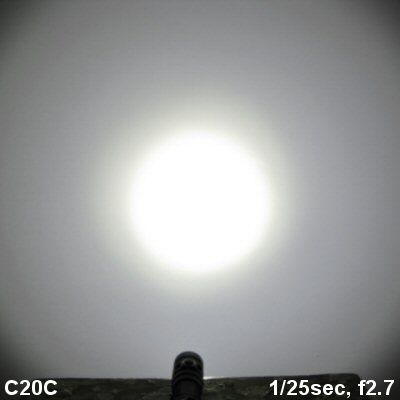
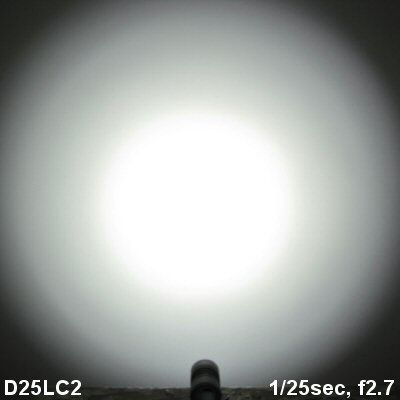
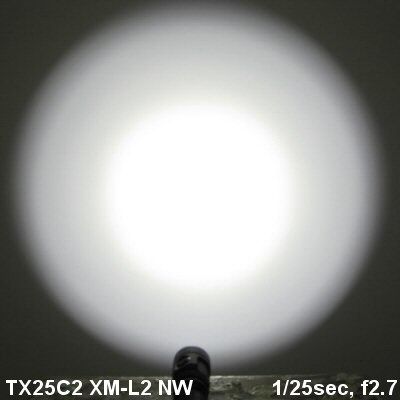
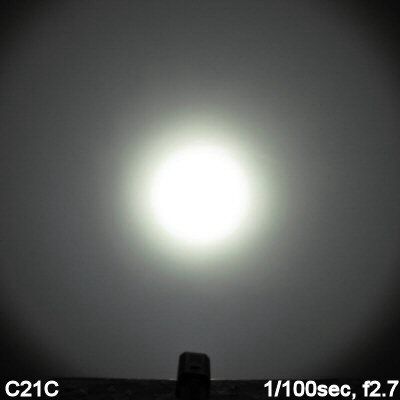
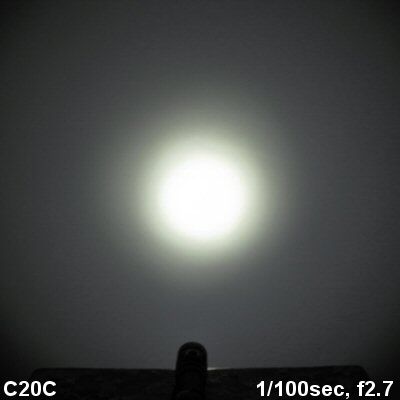
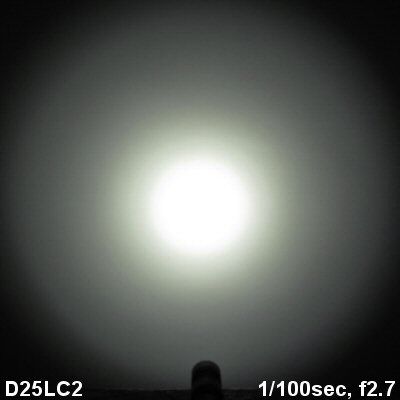
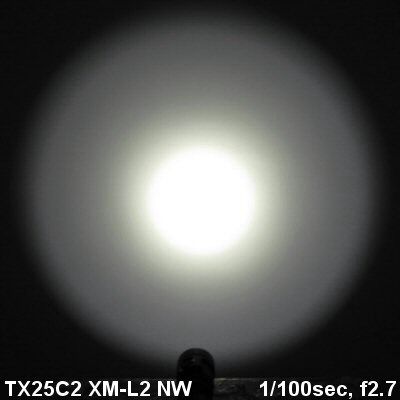
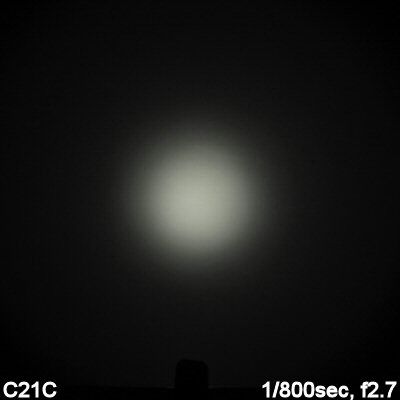
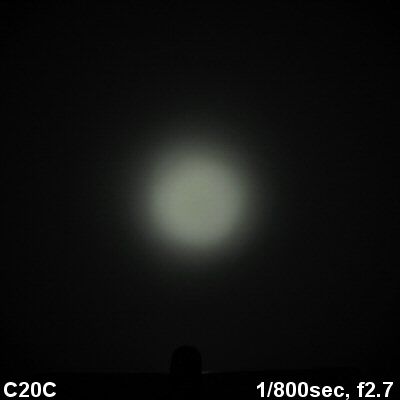
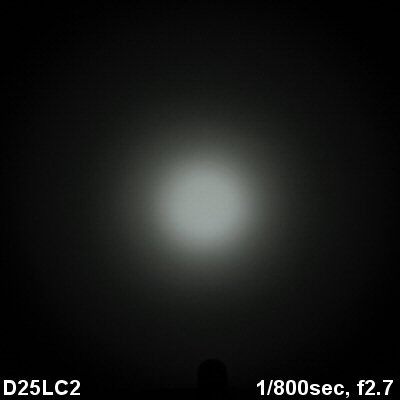
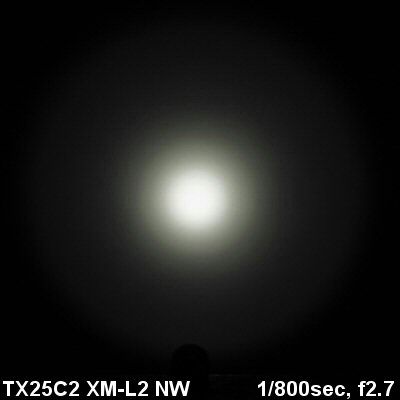
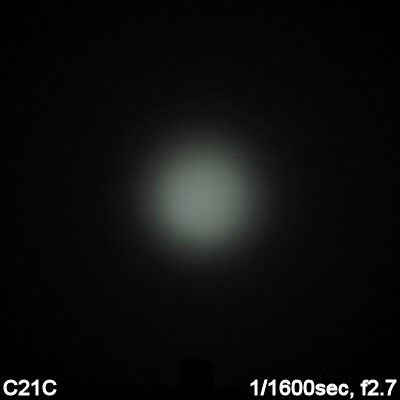
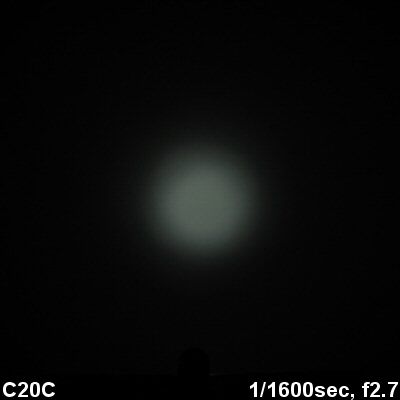
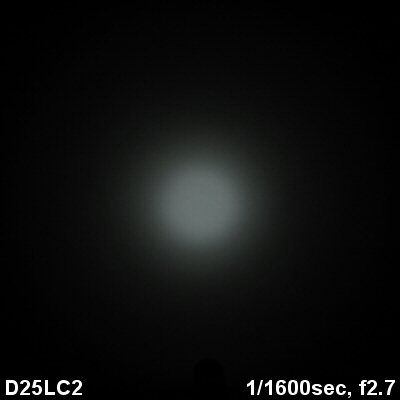
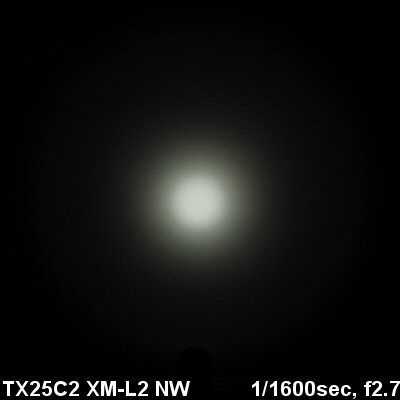
Overall beam pattern is similar to the earlier C20C – only with greater output now.
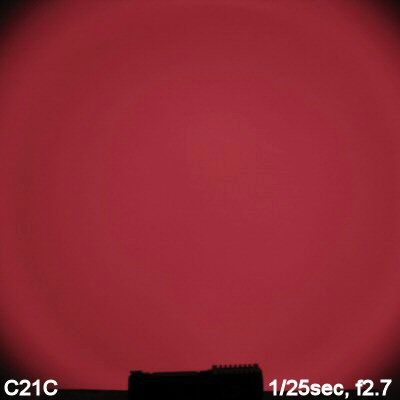
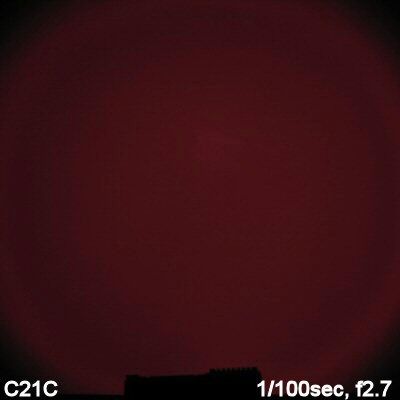
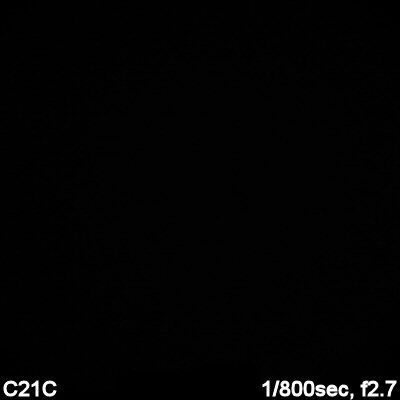
The red beam is interesting – there is no real hotspot to speak of, just a fairly even smooth beam with a sharp spillbeam edge. The red convex optic seems to help maintain a clear demarcation of the spill.
Testing Method:
All my output numbers are relative for my home-made light box setup, as described on my flashlightreviews.ca website. You can directly compare all my relative output values from different reviews - i.e. an output value of "10" in one graph is the same as "10" in another. All runtimes are done under a cooling fan, except for any extended run Lo/Min modes (i.e. >12 hours) which are done without cooling.
I have devised a method for converting my lightbox relative output values (ROV) to estimated Lumens. See my How to convert Selfbuilt's Lightbox values to Lumens thread for more info.
Throw/Output Summary Chart:
My summary tables are reported in a manner consistent with the ANSI FL-1 standard for flashlight testing. Please see http://www.flashlightreviews.ca/FL1.htm for a discussion, and a description of all the terms used in these tables. Effective July 2012, I have updated all my Peak Intensity/Beam Distance measures with a NIST-certified Extech EA31 lightmeter (orange highlights).
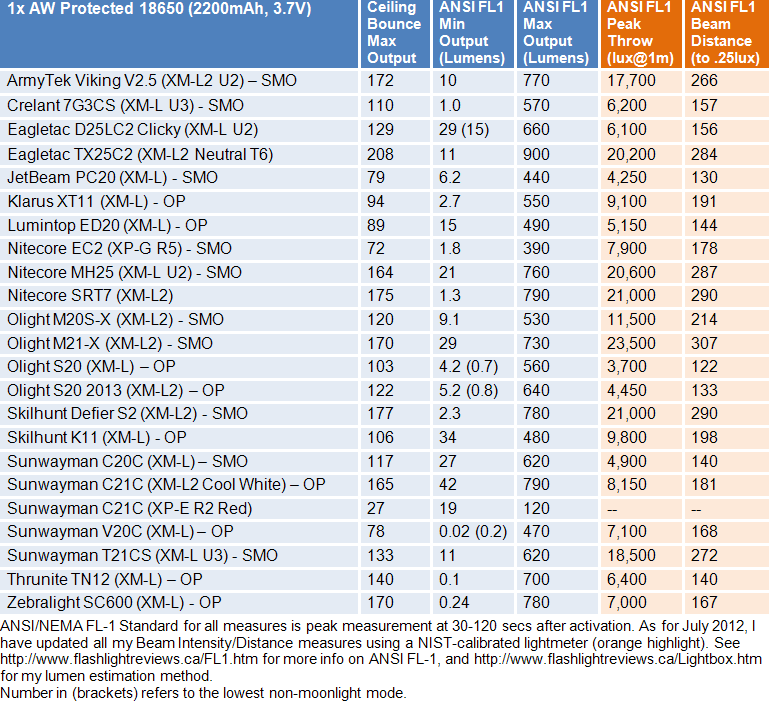
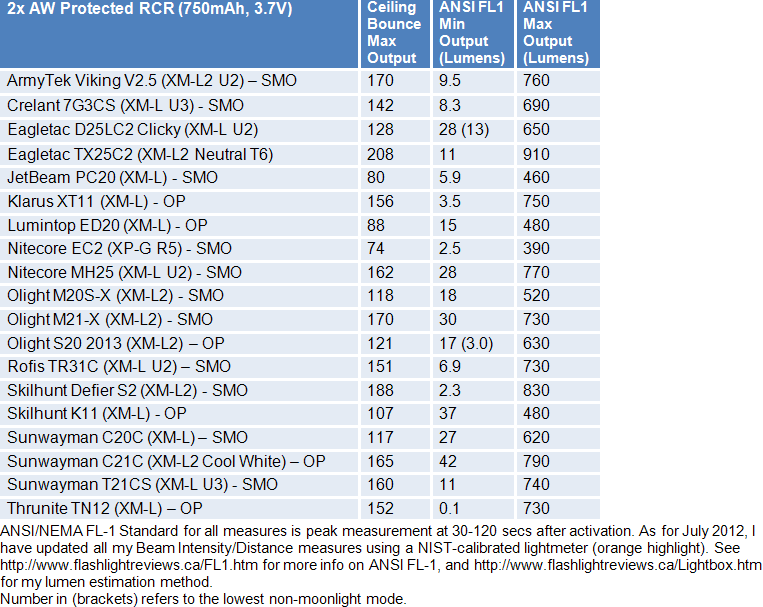
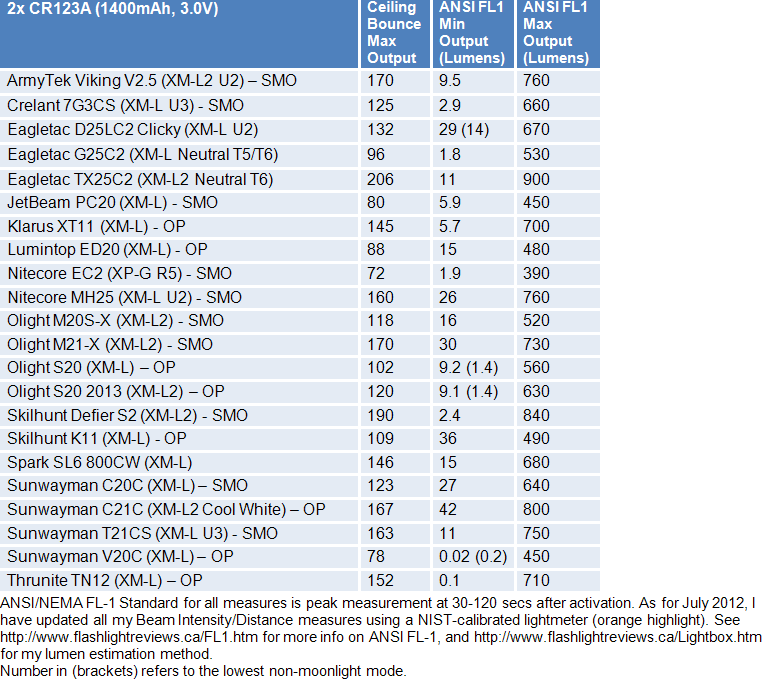
As you could tell from the beamshots, overall output has increased on the C21C white beam, compared to the earlier C20C. The C21C is in keeping with the higher-end of output for compact XM-L/XM-L2 lights. In fact, it is one of the highest max outputs I've seen in a light this small.
The light performs consistently on all battery sources. Note that it doesn't really have a true low mode, unfortunately.
My peak intensity throw and beam distance measures are very consistent Sunwayman ANSI FL-1 specs.
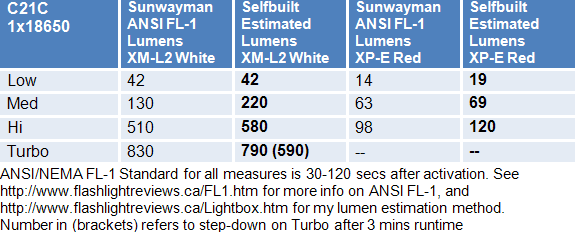
Overall, my lumen estimates are pretty close to Sunwayman's output specs - on all levels on both emitters. It's just my Med white mode that seems a little higher than spec.
One comment here – I find these red LED modes extremely bright in practice. oo: I personally would have preferred to have seen an even lower Lo mode (i.e., "moonlight/firefly" level brightness).
oo: I personally would have preferred to have seen an even lower Lo mode (i.e., "moonlight/firefly" level brightness).
Output/Runtime Graphs:
Let's start with a comparison of the Med-Turbo modes, on both emitters:

As you can see, on Turbo (white LED) the light steps down after ~3.5 mins to the defined Hi mode. Overall runtime is thus fairly similar. The Hi mode is still fairly bright for this class of light.
The red LED has lower overall output and runtime, in keeping with the lower output XP-E emitter (and additional red dome, which likely further cuts output).
Also note the definite step-down pattern as the batteries drain. This is a convenient way to warn the user that batteries are nearly exhausted.
Let's see how it compares to the competition:
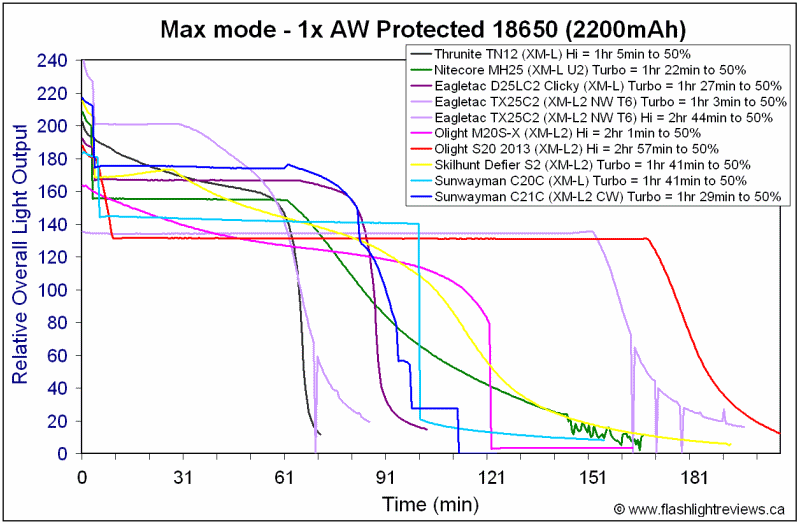
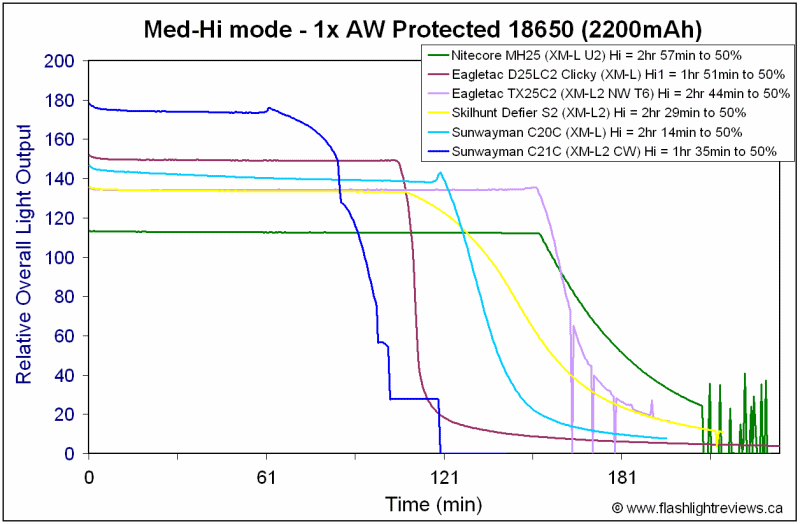
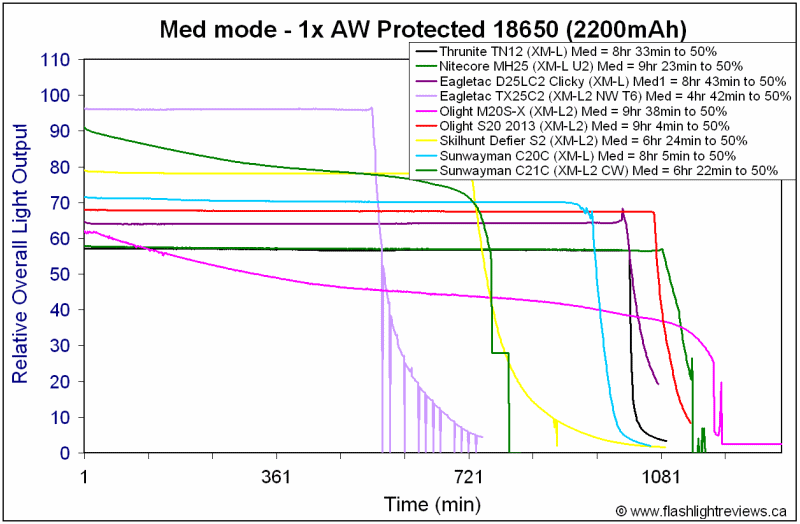
(sorry, I accidentally switched colors here – the C21C is in green instead of blue)

(sorry, I accidentally switched colors here – the C21C is in green instead of blue)
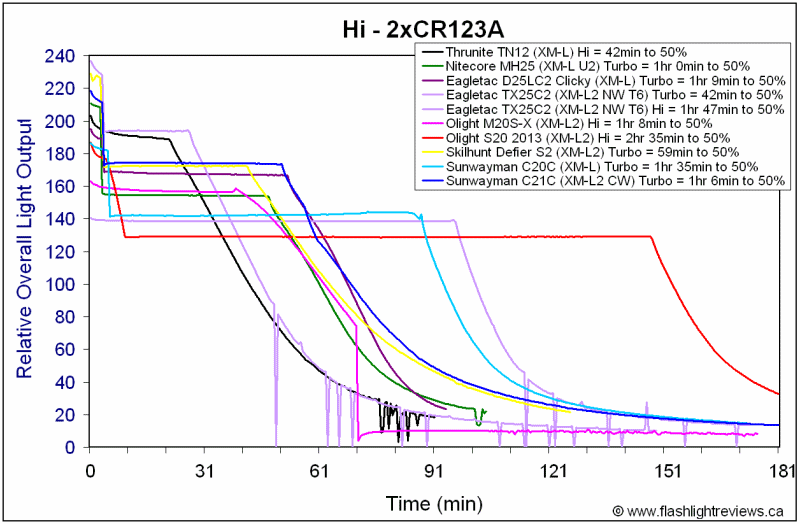
Performance is good, in keeping with a current-controlled circuit.
Sunwayman's runtime specs also seem pretty good for 18650 (note that ANSI FL-1 standard is time to 10% output, and most manufacturers use higher capacity cells than mine above). I am confident that ~3100mAh 18650 would meet the official runtime specs.
Potential Issues
The electronic switch is smaller than typical, and may be hard to access with gloves on. User interface may take a little getting used. Mode memory is not independently maintained for the two emitters modes (i.e., only one common memory store for last mode/output level used).
Light lacks a true Lo mode – on either white or red LEDs.
Package lacks a holster or pocket clip. Lack of a pocket clip seems particularly odd, given the side-facing red emitter (i.e., would be convenient to clip on to clothing to carry, like an angle-head light).
Preliminary Observations
The C21C is a distinctive new light from Sunwayman. Although I am not generally one for descriptive model names (and prefer simple model numbers), "Thunder Hammer" does elicit a knowing chuckle when you see the light in person. At least for those of us who read superhero comic books in our youth.
The light certainly packs a punch in light output for the size. oo: And despite the moniker, the light is actually remarkably compact in person. Ergonomics and hand feel are good, although you might find it to be a bit small (if you have large hands).
oo: And despite the moniker, the light is actually remarkably compact in person. Ergonomics and hand feel are good, although you might find it to be a bit small (if you have large hands).
The other distinctive feature of course is the red flood light on the side off the head - as an alternative to using a diffuser on the main white beam. This also give you the opportunity to use the light in an angle-head fashion. Although in this regard, it is odd they didn't provide even a basic pocket clip. :thinking:
The single switch is a bit on the small side, and the user interface may not be entirely intuitive given that all features that need to be controlled by it. But once you get the handle of it, it works pretty well. My only comment here is that I would like to see lower Lo modes (on both red and white LEDs). And separate memory modes for each emitter would be nice.
Beam patterns are good. On the white beam, you will see a pattern very similar to the earlier C20C, but with greater max output. The red beam is very distinctive - the convex optic creates a very defined spill, with roughly consistent output across the beam width. It is really something to see - a very true red beam, thanks to the red XP-E and red-tinted dome. It is also surprisingly bright - the lumens estimates don't really capture how bright it actually seems in real life, especially in an enclosed environment. In fact, I find it too bright for dark-adapted eyes, even on its lowest setting.
Output/runtime performance is very good, consistent with a current-controlled circuit.
The C21C is an unique light in my testing, and one with a versatile feature set (thanks to secondary red LED). It is remarkably compact for class, yet still carries quite the output "punch." Hopefully the detailed description and performance testing in this review will help you decide if it is right for you. :wave:
----
C21C was provided by Sunwayman for this review.



Sunwayman has updated their streamlined 1x18650 offering – the C20C – with a new dual-emitter version, the C21C. This new light is distinctive for having a XM-L2 cool white main emitter, and a XR-E red side emitter.
Sunwayman continues its recent tradition of naming all of its models – the C21C sports the moniker of "Thunder Hammer". Perfect for everyone's favorite Norse god.
Let's see how the model has evolved - and how it compares to other recent lights in the popular 1x18650, 2xCR123A/RCR class of XM-L2 lights.
Manufacturer Reported Specifications:
(note: as always, these are simply what the manufacturer provides – scroll down to see my actual testing results).
- CREE XM-L2 white LED and XP-E P2 red LED
- Side switch on the top, 6 output modes
- White Light: Turbo: 830 Lumens (Automatically enter High mode after 5 mins continuous use to avoid overheat), High: 510 Lumens (1.9hrs.), Mid: 130 Lumens (9.5hrs.), Low: 42 Lumens (31hrs.), Strobe, SOS
- Red Light: High: 98 Lumens(3hrs), Mid: 63 Lumens (9hrs), Low: 14 Lumens (45hrs), Strobe, SOS
- Beam Intensity: 8800cd
- Effective range of 188 meters
- Uses one single 18650 battery (2*CR123A/16340 batteries)
- Working voltage: 2.8~8.4V
- Constant current circuit, constant output
- White light uses high quality metal reflector, maintains great throw distance and spread with an ideal beam pattern; Red light uses high quality resin lens
- Aerospace-grade aluminum alloy, Stainless Steel retaining ring on the top
- Military Specification Type III- hard anodized body
- Impact resistance to 2m
- Waterproof, in accordance with IPX-8 standard to 2m
- Ultra-clear tempered glass lens resists scratches and impacts
- Tail stand capable- can be used as a candle
- Dimensions: 27mm (head diameter) x 107mm (length)
- Weight: 78g (Excluding Battery)
- Accessories: Lanyard, O-ring
- MSRP: ~$73

The C21C comes in the standard Sunwayman display-style cardboard box with product information printed right on the package. Inside you get a wrist lanyard, extra o-rings, manual and product inserts. There is no belt pouch or clip included.



From left to right: Rayovac CR123A; AW Protected 18650 2200mAh; Sunwayman C212C, C20C; Olight S20-L2; Nitecore EC2; Eagletac D25LC2; Zebralight SC600.
All dimensions directly measured, and given with no batteries installed:
Sunwayman C21C: Weight 78.6g, Length: 102.0mm, Width (bezel side) 26.9mm (bezel diagonal) 31.2mm
Sunwayman C20C: Weight 57.6g, Length: 104.8mm. Width (bezel): 25.6mm, Width (head at widest part): 28.6mm
Eagletac D25LC2: Weight: 50.0g, Length: 116.3mm, Width (bezel): 22.5mm
Eagletac G25C2-II (stock): Weight 141.0g, Length: 150.6mm, Width: 39.6mm
Eagletac TX25C2: Weight 93.6g, Length: 120.4mm, Width (bezel): 31.6mm
Foursevens Quark Q123-2 X (Regular tailcap): Weight: 44.6g, Length: 112.7mm, Width (bezel) 22.0mm
Jetbeam PC20: Weight: 60.0g, Length: 127.5mm, Width (bezel): 22.6mm
Olight M21: Weight 119.5g, Length 145.2mm, Width 38.5mm (bezel)
Skilhunt S2: Weight: 133.0g, Length 153.0mm, Width: 36.0mm
Zebralight SC600 II: Weight 79.3g, Length: 108.0mm, Width (bezel) 29.7mm
Overall dimensions are similar to other compact/petite lights in this class.






The appearance of the C21C is certainly a departure from the C20C. The most obvious change is the square-shaped head and side-mounted red LED (under a red dome).
The size of the main electronic switch is also a lot less pronounced now. Not quite sure why this latter change was made, but I suppose it could reduce accidental activations (which were an issue on the C20C). But it also makes it a bit harder to find the switch by touch alone now. :shrug: Switch feel is reasonable for this type of switch, with a definite "click" upon activation. There is also a dedicated low-battery warning LED indicator just above the switch. Scroll down for a discussion of the UI.
As with several other recent Sunwayman lights, the light comes in black anodizing, type III (hard anodized), in a matte finish. Personally, I miss the dark gray natural finish anodizing of old. As always, all labels are fairly small and bright white against the dark background.
There is no real knurling to speak of on the C21C, but there are a number of ridge elements on the body and fine gradations on the tailcap. Given the shape of the light, I would say overall grip is reasonable. I am not clear on why Sunwayman dropped the pocket clip on the C21C. It would be particularly useful here, given the side-mounted red LED (i.e., to clip it onto you for use like an angle-head light). :thinking:
The light opens at the tailcap, and screw threads are a thick square-cut and fully anodized for lock-out. :thumbsup:
The body tube is wide enough to take protected 18650 cells, as well as 2xCR123A/RCR. You might find longer cells a bit of tight fit, given the spring in the head. On the plus side, all flat-top cells will work in the light.
There is a stainless steel bezel for the main white emitter.


The main reflector is textured, to a medium orange peel finish. XM-L2 cool white emitter was well centered on my sample.

Sunwayman confirms that there is an actual red XP-E LED under there (hard to tell with the red dome). In the absence of a reflector, the convex optic helps to focus light into a defined beam (scroll down for beamshots). Not quite sure why they used a red-tinted optic, unless this was to narrow the wavelength even further. :shrug:
User Interface
Turn the white light on by clicking the electronic switch (i.e. a quick press and release, from off). Click again to turn the light off. Turn the red light on by pressing and holding the switch (from off). Again click to turn off.
There are four main output levels of white light, selected by pressing and holding the switch when on. The light will advance through all the levels in the following repeating sequence: Turbo > Hi > Med > Lo.
For the red light, you similarly press and the hold the switch again (after turning the red light on) to change levels. The level sequence is Hi > Med > Lo, in a repeating loop.
The light has level memory, but only for the current mode. So for example, if you turn the light off in the white Lo mode, and then re-active (in white), you will get Lo again. But if you re-activate in red, the white level memory is erased and the new red level is saved upon turning off the light. :shrug: Note also that the default level is max output, for either mode (i.e., when you switch to the other color, it first activates in max).
Double-click from on (in either white or red mode) to activate Strobe. Double-click again to advance to SOS. A single click returns you to constant on.
As this is an electronic switch, a standby current is required (see below for measurements). From on, do a quick click followed immediately by a press-hold. After 1 sec, the light will shut off and cannot be re-activated until the lockout is deactivated. To restore full functioning, double-click the switch followed by a press-hold. Note that manual is bit unclear on this point (i.e., it says to use the same procedure to lock and unlock, when in fact you need to do an extra click to unlock).
There is a low voltage warning indicator on the light, just above the electronic switch. It comes on (constant on) when the batteries are nearly depleted. I didn't test to see specifically when it activates, but I did notice it at the end of some of my runtimes.
Video:
For information on the light, including the build and user interface, please see my video overview:
Video was recorded in 720p, but YouTube typically defaults to 360p. Once the video is running, you can click on the configuration settings icon and select the higher 480p to 720p options. You can also run full-screen.
As with all my videos, I recommend you have annotations turned on. I commonly update the commentary with additional information or clarifications before publicly releasing the video.
PWM/Strobe
As with most of my Sunwayman lights, I don't see any signs of pulse width modulation (PWM) on the lower output modes. There is some measurable circuit noise on my C21C, in some modes – although it is not visible to the eye:
White Med Noise:


White Lo Noise:


I don't see any circuit noise on the Hi or Turbo white modes, but the above patterns are detectable on Lo (9 kHz) and Med (22 kHz). Only the Med mode noise was intense enough to be able to see visually when shinning on a fan. However, I didn't detect any visual flicker in actual use (and I am personally sensitive to flicker effects).
White Strobe:

The main strobe is a typical high frequency ~12 Hz strobe. Note that I can detect a bit of circuit noise at the end of each strobe pulse.
White SOS:

The C21C has a typical SOS mode.
Red mode Hi Noise:

On the Red light, I detected circuit noise on the Med and Hi modes with my oscilloscope, whereas Lo was perfectly stable. Again, I could see no sign of flicker on any of the red modes in actual use (but you may be able to see the noise when shining the light on a fan).
Red mode Strobe:

The red strobe is the same fast 12 Hz strobe, although you can again see the Hi mode circuit noise in the trace above.

Red SOS mode is also fairly typical.
Take home message: don't worry about these oscilloscope-detectable noise patterns. They are of sufficiently high frequency (multi-kilohertz range) and low intensity as not to be detectable visually. :wave:
Standby Drain
As the switch is an electronic one, a standby current drain is always present when a battery is installed.
When I first connect my DMM, I measured an initial current of ~880uA (on an 18650 cell). However, after a few seconds, the stand-by drain dropped to 13.3uA, and remained there stably. This would translate into nearly 27 years before a 3100mAh battery would be drained. It is definitely negligible, and not a concern.
Sunwayman provides an electronic lock-out mode that is activated by a quick click followed by a sustained press (see UI section – same as the C20C). You can also physically lock-out the C21C by a twist of the tailcap (thanks to the anodized threads).
Beamshots:
For white-wall beamshots below, all lights are on Max output on an AW protected 18650 battery. Lights are about ~0.75 meter from a white wall (with the camera ~1.25 meters back from the wall). Automatic white balance on the camera, to minimize tint differences.
















Overall beam pattern is similar to the earlier C20C – only with greater output now.



The red beam is interesting – there is no real hotspot to speak of, just a fairly even smooth beam with a sharp spillbeam edge. The red convex optic seems to help maintain a clear demarcation of the spill.
Testing Method:
All my output numbers are relative for my home-made light box setup, as described on my flashlightreviews.ca website. You can directly compare all my relative output values from different reviews - i.e. an output value of "10" in one graph is the same as "10" in another. All runtimes are done under a cooling fan, except for any extended run Lo/Min modes (i.e. >12 hours) which are done without cooling.
I have devised a method for converting my lightbox relative output values (ROV) to estimated Lumens. See my How to convert Selfbuilt's Lightbox values to Lumens thread for more info.
Throw/Output Summary Chart:
My summary tables are reported in a manner consistent with the ANSI FL-1 standard for flashlight testing. Please see http://www.flashlightreviews.ca/FL1.htm for a discussion, and a description of all the terms used in these tables. Effective July 2012, I have updated all my Peak Intensity/Beam Distance measures with a NIST-certified Extech EA31 lightmeter (orange highlights).



As you could tell from the beamshots, overall output has increased on the C21C white beam, compared to the earlier C20C. The C21C is in keeping with the higher-end of output for compact XM-L/XM-L2 lights. In fact, it is one of the highest max outputs I've seen in a light this small.
The light performs consistently on all battery sources. Note that it doesn't really have a true low mode, unfortunately.
My peak intensity throw and beam distance measures are very consistent Sunwayman ANSI FL-1 specs.

Overall, my lumen estimates are pretty close to Sunwayman's output specs - on all levels on both emitters. It's just my Med white mode that seems a little higher than spec.
One comment here – I find these red LED modes extremely bright in practice.
Output/Runtime Graphs:
Let's start with a comparison of the Med-Turbo modes, on both emitters:

As you can see, on Turbo (white LED) the light steps down after ~3.5 mins to the defined Hi mode. Overall runtime is thus fairly similar. The Hi mode is still fairly bright for this class of light.
The red LED has lower overall output and runtime, in keeping with the lower output XP-E emitter (and additional red dome, which likely further cuts output).
Also note the definite step-down pattern as the batteries drain. This is a convenient way to warn the user that batteries are nearly exhausted.
Let's see how it compares to the competition:



(sorry, I accidentally switched colors here – the C21C is in green instead of blue)

(sorry, I accidentally switched colors here – the C21C is in green instead of blue)

Performance is good, in keeping with a current-controlled circuit.
Sunwayman's runtime specs also seem pretty good for 18650 (note that ANSI FL-1 standard is time to 10% output, and most manufacturers use higher capacity cells than mine above). I am confident that ~3100mAh 18650 would meet the official runtime specs.
Potential Issues
The electronic switch is smaller than typical, and may be hard to access with gloves on. User interface may take a little getting used. Mode memory is not independently maintained for the two emitters modes (i.e., only one common memory store for last mode/output level used).
Light lacks a true Lo mode – on either white or red LEDs.
Package lacks a holster or pocket clip. Lack of a pocket clip seems particularly odd, given the side-facing red emitter (i.e., would be convenient to clip on to clothing to carry, like an angle-head light).
Preliminary Observations
The C21C is a distinctive new light from Sunwayman. Although I am not generally one for descriptive model names (and prefer simple model numbers), "Thunder Hammer" does elicit a knowing chuckle when you see the light in person. At least for those of us who read superhero comic books in our youth.
The light certainly packs a punch in light output for the size.
The other distinctive feature of course is the red flood light on the side off the head - as an alternative to using a diffuser on the main white beam. This also give you the opportunity to use the light in an angle-head fashion. Although in this regard, it is odd they didn't provide even a basic pocket clip. :thinking:
The single switch is a bit on the small side, and the user interface may not be entirely intuitive given that all features that need to be controlled by it. But once you get the handle of it, it works pretty well. My only comment here is that I would like to see lower Lo modes (on both red and white LEDs). And separate memory modes for each emitter would be nice.
Beam patterns are good. On the white beam, you will see a pattern very similar to the earlier C20C, but with greater max output. The red beam is very distinctive - the convex optic creates a very defined spill, with roughly consistent output across the beam width. It is really something to see - a very true red beam, thanks to the red XP-E and red-tinted dome. It is also surprisingly bright - the lumens estimates don't really capture how bright it actually seems in real life, especially in an enclosed environment. In fact, I find it too bright for dark-adapted eyes, even on its lowest setting.
Output/runtime performance is very good, consistent with a current-controlled circuit.
The C21C is an unique light in my testing, and one with a versatile feature set (thanks to secondary red LED). It is remarkably compact for class, yet still carries quite the output "punch." Hopefully the detailed description and performance testing in this review will help you decide if it is right for you. :wave:
----
C21C was provided by Sunwayman for this review.
Last edited:

